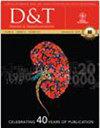下载PDF
{"title":"Management of a hemophilia patient in renal replacement therapy","authors":"Patrícia Aparecida Barbosa Silva RN, Sônia Maria Soares RN, PhD (Public Health), Gisele Fráguas RN, Fada Marina de Oliveira Vaz RN, Maria José da Silva RN, José Gabriel da Silva Júnior MD","doi":"10.1002/dat.20580","DOIUrl":null,"url":null,"abstract":"<p>We describe the case of a male hypertensive patient with severe hemophilia A. In August 1999 he was admitted to our nephrology department, with hemarthrosis, severe hypertension, dyspnea with minimal efforts, increasing blood urea nitrogen, anemia, uremic symptoms, reduced urine volume, mild edema of the lower limbs, and no hyperkalemia. Imaging confirmed the diagnosis of end-stage renal disease. A Tenckhoff peritoneal dialysis catheter was inserted, and he began continuous ambulatory peritoneal dialysis. In August 2005 he evolved to peritoneal failure (peritoneal equilibration test showing ultrafiltration disorder I) and was transferred to hemodialysis. A permanent catheter was inserted into the right subclavian vein. Hemodialysis sessions lasted 4 hours, three times a week, and gradually resulted in hemodynamic stabilization. In September 2005, an arteriovenous fistula was placed in the right forearm between the cephalic vein and the radial artery. In January 2007 the patient was admitted with abdominal and epigastric pain, double-lumen catheter infection, peritoneal catheter infection, globoid tympanic abdomen, and mild pain on palpation. Preliminary studies showed a large preperitoneal hematoma with bowel compression. Due to the catheter infection, we decided to puncture the fistula using a 17-G needle. Apart from some bleeding during and after the beginning of hemodialysis, there were no other fistula complications. The patient had progressive worsening of clinical symptoms and died in February 2007. In summary, an individualized treatment plan, mainly adequate hemostatic monitoring, care of the dialysis access, and multiprofessional and family involvement, may help in the management of hemophilia patients undergoing dialysis. Dial. Transplant. © 2011 Wiley Periodicals, Inc.</p>","PeriodicalId":51012,"journal":{"name":"Dialysis & Transplantation","volume":"40 6","pages":"262-263"},"PeriodicalIF":0.0000,"publicationDate":"2011-06-01","publicationTypes":"Journal Article","fieldsOfStudy":null,"isOpenAccess":false,"openAccessPdf":"https://sci-hub-pdf.com/10.1002/dat.20580","citationCount":"3","resultStr":null,"platform":"Semanticscholar","paperid":null,"PeriodicalName":"Dialysis & Transplantation","FirstCategoryId":"1085","ListUrlMain":"https://onlinelibrary.wiley.com/doi/10.1002/dat.20580","RegionNum":0,"RegionCategory":null,"ArticlePicture":[],"TitleCN":null,"AbstractTextCN":null,"PMCID":null,"EPubDate":"","PubModel":"","JCR":"","JCRName":"","Score":null,"Total":0}
引用次数: 3
引用
批量引用
Abstract
We describe the case of a male hypertensive patient with severe hemophilia A. In August 1999 he was admitted to our nephrology department, with hemarthrosis, severe hypertension, dyspnea with minimal efforts, increasing blood urea nitrogen, anemia, uremic symptoms, reduced urine volume, mild edema of the lower limbs, and no hyperkalemia. Imaging confirmed the diagnosis of end-stage renal disease. A Tenckhoff peritoneal dialysis catheter was inserted, and he began continuous ambulatory peritoneal dialysis. In August 2005 he evolved to peritoneal failure (peritoneal equilibration test showing ultrafiltration disorder I) and was transferred to hemodialysis. A permanent catheter was inserted into the right subclavian vein. Hemodialysis sessions lasted 4 hours, three times a week, and gradually resulted in hemodynamic stabilization. In September 2005, an arteriovenous fistula was placed in the right forearm between the cephalic vein and the radial artery. In January 2007 the patient was admitted with abdominal and epigastric pain, double-lumen catheter infection, peritoneal catheter infection, globoid tympanic abdomen, and mild pain on palpation. Preliminary studies showed a large preperitoneal hematoma with bowel compression. Due to the catheter infection, we decided to puncture the fistula using a 17-G needle. Apart from some bleeding during and after the beginning of hemodialysis, there were no other fistula complications. The patient had progressive worsening of clinical symptoms and died in February 2007. In summary, an individualized treatment plan, mainly adequate hemostatic monitoring, care of the dialysis access, and multiprofessional and family involvement, may help in the management of hemophilia patients undergoing dialysis. Dial. Transplant. © 2011 Wiley Periodicals, Inc.


